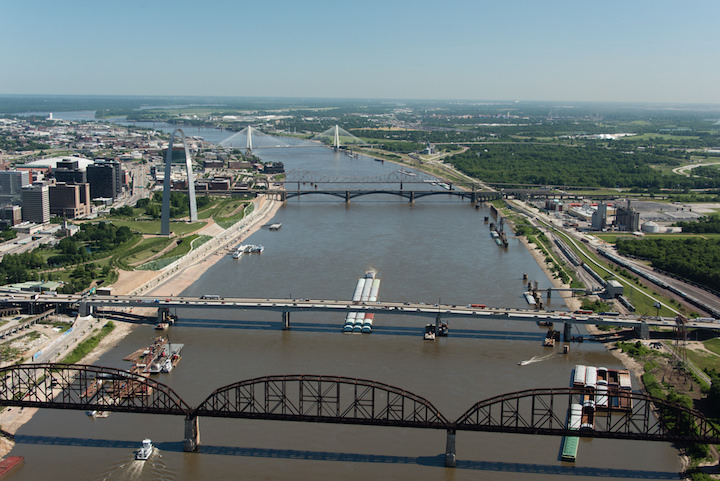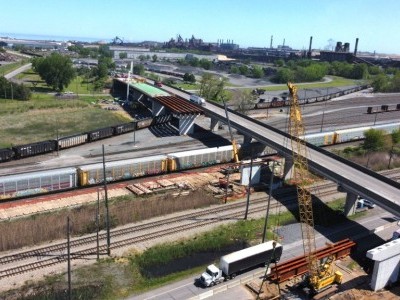St. Louis Region’s Freight Network Delivers Essential Shipments During COVID-19 Pandemic
Apr 27, 2020Goods continue to move to and through the bi-state area, underscoring the adaptability of the network and how those employed in the freight sector are among the essential workers keeping our economy moving
As the COVID-19 pandemic continues to impact the movement of goods into, out of and throughout the United States, the consistent response across the freight network in the bi-state St. Louis region is helping to ensure it continues to deliver in these unprecedented times.

America’s Central Port and Terminal Railroad Association of St. Louis (TRRA) were swift to implement measures such as social distancing, transitioning most office staff to work from home, having field supervisors alternate work days, increasing sanitation efforts for equipment, workspaces, and jobsites, and introducing new procedures, such as having employees report directly to job sites for safety briefings instead of congregating indoors. The port implemented two-person teams in the maintenance department to significantly reduce any potential exposure to the virus, while operators are taking temperature readings of employees entering or leaving their towboats at the beginning and end of their shifts. They also interview each employee about their wellbeing to quickly identify any symptoms.
Dennis Wilmsmeyer, Executive Director of America’s Central Port (ACP), says that even with all these changes, the operators at the port continue to handle a tremendous volume of corn and soybeans, and the by-products, destined to ultimately feed the U.S. and the world.
“It has been business as usual with a tremendous amount of freight still moving to and through the St. Louis area. Everyone has heightened awareness of the need to reduce potential exposure to the virus and are limiting any close contact with other workers, but the food stock and freight continue to move,” said Wilmsmeyer. “The operators here are just as essential to keeping the supply of food on the shelves as the truck driver who makes those daily deliveries.”
Brad Reinhardt, president of Rockfarm St. Louis Supply Chain Solutions, which provides St. Louis local and national over-the-road services, says that one of the biggest things his company did at the very beginning of the COVID-19 outbreak was contact its contracted carriers to discuss truck driver safety and capacity through this. The focus has been on making sure all were following the recommended CDC guidelines.
“They are the lifeblood of the system,” said Reinhardt. “They are first responders without being in the medical field.”
Reinhardt says his customers are currently being impacted in different ways, with one-third of his customers temporarily closed and one-third on a vastly reduced shipping schedule.
“Thankfully the other third handles beer, dog food and ammunition, and it’s still moving,” said Reinhardt. “Locally, we have customers who are having some of their best months because they are moving those goods. That’s helping to offset the temporarily lost business and keeping our operations at a comfortable level.”
Reinhardt adds they are not seeing capacity issues yet due to the flexibility and adaptability of the industry. When the auto plants started shutting down, it freed up a lot of trucks that were able to move to more essentials such as groceries and medical items. As a result, all the trucking companies are staying busy. He notes that truckers, concerned for their own safety, prefer to come to areas like St. Louis over densely populated areas like New York or Chicago.
“We can’t be naïve enough to think this is the last time something like this could happen. Going forward, I think companies will look increasingly to the Midwest, including the St. Louis region, for their distribution facilities, because they’ll see that we’re less impacted than cities on the coasts,” said Reinhardt. “We’re more spread apart and not living in close proximity, which makes it easier to deal with a disaster like this. Our supply chain is still running fairly smoothly.”
On the rail side, as the COVID-19 pandemic has spread, TRRA has seen a particularly noticeable drop in intermodal traffic, presumptively due to falling imports from China, while also seeing a drop in traffic volumes from auto plant closings. But it’s not all bad news.
“Medical supplies, food, chemicals, cleaning products and anything else being used to battle the pandemic continues to be moved through the St. Louis Gateway headed to all parts of the United States via the region’s rail network,” said Asim Raza, Chief Legal Officer, Director of Corporate Affairs for TRRA. “As the situation continues to evolve, TRRA understands that the freight rail network is a critical part of the nation’s infrastructure. With its ability to connect the six Class I railroads in the heart of the country, TRRA is committed to maintaining its switching operations to ensure that food, medical equipment and other vital products continue to move through the St. Louis region. In doing so, TRRA will maintain the safety of its valued personnel as a top priority.”
Ken Eriksen, Senior Vice President with IHS Markit, a world leader in critical information, analytics and solutions for the major industries and markets that drive economies worldwide, isn’t surprised by the performance of the St. Louis region’s freight network during this unprecedented time.
“When we do a postmortem on this, the St. Louis region will likely have come through fairly unscathed and stands better to be even more of a distribution hub as we think about heading into the Chicago market or Kansas City or even up over toward Ohio for that matter, just because you have the connectivity and can extend your reach,” said Eriksen. “The world still has to eat; the world still has to consume certain things, and that’s good for St. Louis and for U.S. farmers.
In the midst of the pandemic, work is continuing on some of the significant infrastructure projects underway to further enhance the region’s freight network. Among those is the $222 million project to replace the Merchant’s Rail Bridge, a vital artery across the Mississippi River and one of the nation’s primary east-west rail corridors serving the nation’s third largest rail hub. The project is being largely being funded by TRRA, which owns the bridge, with $21.5 million of the cost supported by a federal grant. High river levels have delayed the main spans of the project, but Raza says work on the Missouri and Illinois approaches to the bridge has been unaffected by COVID-19 to date and is progressing, with no apparent disruptions in labor or material supply at this time. That is positive news for Mary Lamie, Executive Vice President of Multi-Modal Enterprises for Bi-State Development, which oversees the St. Louis Regional Freightway as one of its enterprises.
“The new double track bridge will help move freight faster, cost-effectively and more reliably, providing an alternative to more congested rail regions like Chicago,” Lamie said. “To see this and other projects at the ports and on our interstates continuing to move forward during these this challenging time is an encouraging sign.”
Wilmsmeyer shares her optimism for the future. “We will get through this,” he said. “We have the greatest and most resilient supply chain in the world, as has been demonstrated by our country’s response to this crisis. In one month, factories have been transformed, goods and supplies have been rerouted and, what could have been a crushing blow to grocery stores, has been a blip compared to what it could have been. I encourage people to have faith in this country, faith in the resiliency of the St. Louis region’s freight system, and faith in the efficient movement of goods across the entire network. The St. Louis region’s freight component is second to none.”
Similar Stories

Jeffersonville port delivers record road salt shipments to Greater Louisville area during recent winter storms
View ArticleNC Ports Notice: Holiday Schedule Notice Martin Luther King Jr. Day
The Port of Wilmington Container Gate (South Gate) and the Charlotte Inland Port (CIP) will operate on a reduced schedule on Monday, January 20: 8 AM-12 PM and 1 PM-5…
View Article
Port of Long Beach’s Cordero hails ‘Green Port’ achievements
View Article
Port of San Diego accepts $5 million grant from the San Diego County Air Pollution Control District for clean air project
View Article
Adriatic Gate Container Terminal welcomes Bora Med Service
View Article
Savannah gets India cargo to market up to eight days faster
View ArticleGet the most up-to-date trending news!
SubscribeIndustry updates and weekly newsletter direct to your inbox!





